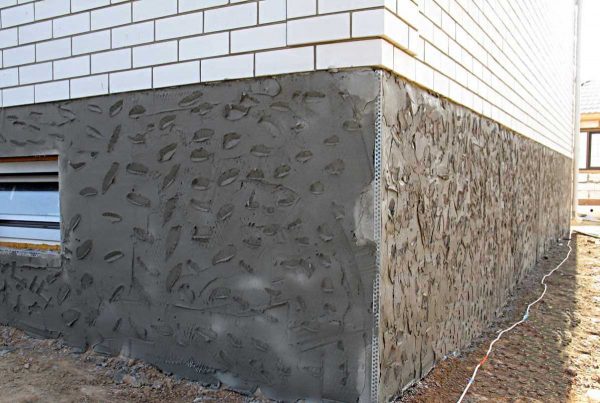Over time, that part of the foundation that protrudes above the surface of the earth begins to collapse. The reason is the impact of natural factors - precipitation, wind, sun, melt water. To protect the support of the house will help finishing the base with plaster. It will seriously reduce the negative impact of the environment, providing not only protective, but also decorative properties.
- Base plaster requirements
- Advantages and disadvantages of plaster for plinth
- The main types of plasters for basement: differences in composition
- Plaster classification by texture
- Classic smooth plasters
- Decorative plasters
- Stucco "under a stone"
- What materials can be used
- Ready-made compounds
- Homemade plaster for plinth
- Surface preparation
- Brick base preparation
- Preparation of rubble and concrete base
- Preparation of concrete and reinforced concrete foundations
- Tools and consumables for work
- Base plastering technology
- Preparatory work
- Soil application
- Fixing plaster mesh and insulation
- Installation of beacons
- Spray
- Plastering
- Grout
- How to paint the base of the house with plaster
- Features of decorative trim base
- Decorative plaster "base stone"
- Wet facade plastering
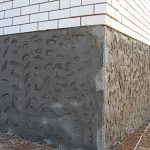
Base plaster requirements
The technology of plastering a plinth with cement and other mortars has been known for a long time. Plastering the foundation, when properly performed, solves a number of critical tasks:
- protection of the monolith from the influence of water, temperature extremes, ultraviolet radiation and other environmental factors;
- additional strengthening of the structure, increasing its durability, strength and reliability;
- decrease in heat loss at home;
- providing decorative finishes.
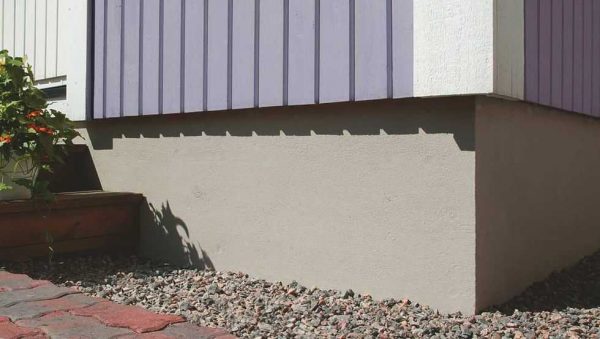
Due to such a high efficiency, plastering of the base has gained great popularity at private buildings. To cover the foundation for a long time and not cause complaints, you need to choose the right materials for finishing work. Base plaster meets the following requirements:
- Moisture resistance. Since the base is most susceptible to moisture (snow, rain, melt water), the coating should prevent its penetration to other structural elements.
- Strength. Plaster is required to reduce damage from vibration, mechanical stress, other types of damage.
- Frost resistance. Since the material will be applied to the outside of the building, it must withstand as many freezing and thawing cycles as possible.
- Resistance to other negative factors. Good base plaster is not afraid of UV rays, the reproduction of mushrooms, bacteria, plants and insects.
- Low thermal conductivity. It is good if the plaster will additionally insulate the structure, which will increase the comfort of living in the house.
- Beautiful appearance. Material for plastering may contain dyes, stone chips, other additives that can decorate the basement of the house.
- Affordable for the price. Since the consumption of plaster for finishing the entire base will be quite large, it is worth choosing a high-quality, but economical material.
to contents ↑
Advantages and disadvantages of plaster for plinth
When deciding whether plastering is needed on the plinth, or whether it can be left without finishing, it is worthwhile to carefully study all the advantages and advantages of such a technology. As was noted, after proper application, the plaster reliably protects the foundation of the house, insulates it and makes it more attractive, so its necessity is not in doubt.
Plastering has other advantages:
- the material is applied on a bare base or on any insulation;
- the mixture for plaster is purchased ready-made or made independently, depending on the capabilities;
- application does not require expensive tools and special knowledge;
- if necessary, do all the work yourself;
- in stores a huge assortment of plasters is presented, which differ in technical characteristics and decorative qualities;
- the dried foundation is painted in any shade with different types of paints;
- vapor permeability of the walls, therefore, the microclimate in the house from the application of plaster is not broken, moisture inside the structures does not accumulate.
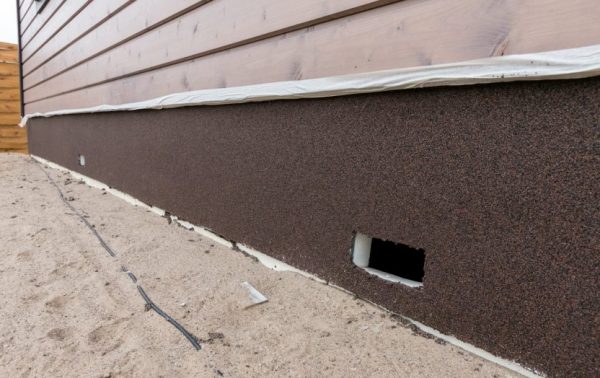
There are also disadvantages to plastering the base. Before severe mechanical impact, the plaster layer may be defenseless. Blow, swing with a shovel, a sharp tool, and the decorative finish will be damaged. Other disadvantages of applying plaster are as follows:
- the total cost of the work will increase, although cost savings in the future usually cover costs;
- the life of the plastered surface is less than after finishing with stone;
- if the solution is applied poorly, cracks may appear in it, and the water that gets into them will sooner or later destroy the site;
- ordinary cement-sand plaster without additives can absorb moisture, so you have to additionally paint the coating.
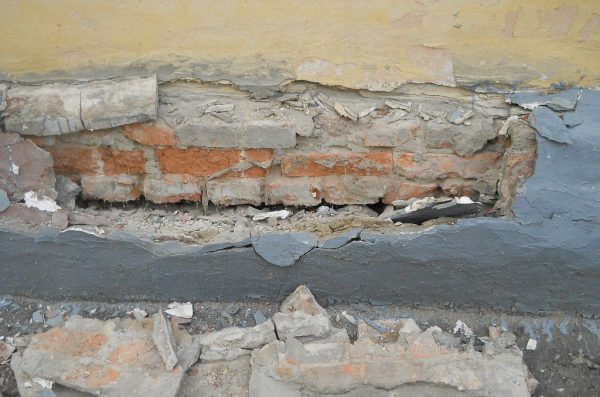
The main types of plasters for basement: differences in composition
In the market of building materials a whole list of plasters, mortars and mixes is presented. Here are their main varieties:
- Plaster cement-sand. The traditional material that is most often used in construction and repair. It is usually prepared from 3 parts of sand and 1 part of cement, it turns out cheap and quite durable. For external use, it is worth adding plasticizers, modifiers to such solutions, and coloring pigments to enhance decorativeness.
- Gypsum plaster. Inexpensive composition with high aesthetic characteristics. It is not suitable for the cap due to fragility, strong absorption of moisture, capriciousness in operation.
- A mixture of clay and sand. It can be prepared independently, and if there is a quarry nearby, it will not require any cash expenses at all. Absolutely environmentally friendly, safe, able to maintain a comfortable microclimate in the room. With the introduction of additional reinforcing additives can be used for finishing the base, and without the involvement of professionals.
- Lime plaster. Consists of slaked lime, sand or other filler, may include some cement and clay. Without strengthening additives it is fragile, when used outdoors it quickly crackes.
- Cement-clay-sand. It is obtained by adding clay to a standard cement mortar. It has increased strength, easy to apply.
to contents ↑
Plaster classification by texture
Depending on the texture, all building mixtures can be divided into two large groups.
Classic smooth plasters
After drying, such solutions remain smooth. Usually they are used to create the first (base) layer, as well as to apply a second layer of facade plaster, if it is planned for subsequent painting.
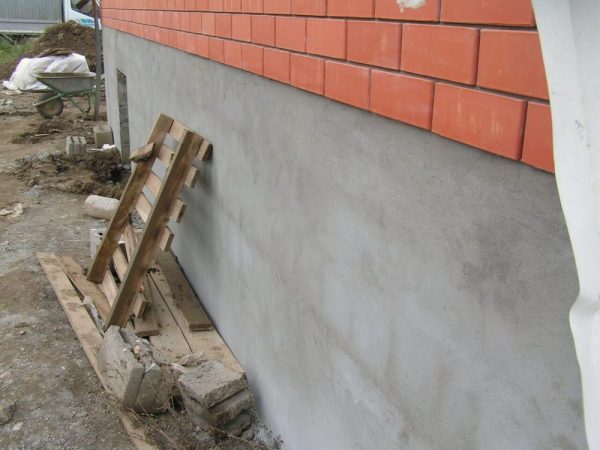
Decorative plasters
Decorative compositions are mixtures of different manufacturers, which, after drying, form a surface with a certain texture and relief. Such compositions look very impressive, suitable for outdoor use, but have a higher price than classic solutions. Decorative plaster can give such effects:
- "Bark beetle" - an original surface with small grooves;
- “Lamb” - the base will become rough after drying;
- "Venetian" - the base will imitate a marble covering.
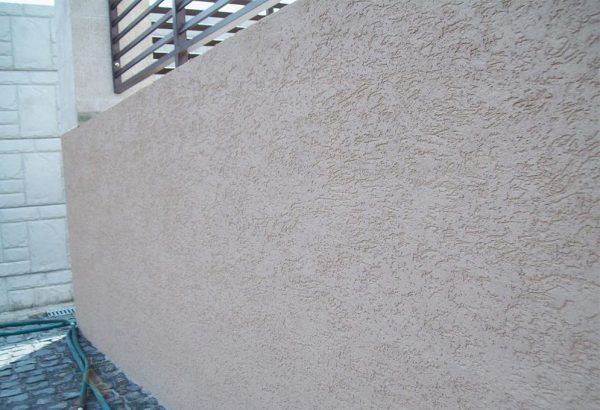
Stucco "under a stone"
Finishing "under the stone" is very popular in construction work on the design of facades and socles. “Stone” plaster consists of cement, quartz sand, plasticizers, cementitious components and small crumbs of stone. The surface after hardening will become very durable, will not allow the base to collapse for many years.
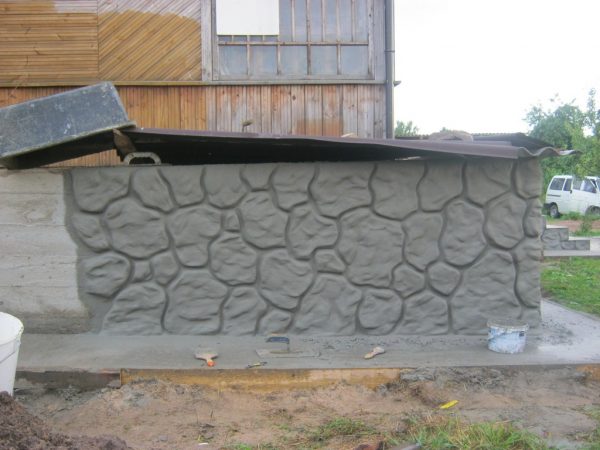
What materials can be used
To choose a really suitable plaster for the base, you need to take into account the features and technical characteristics of different compositions. For example, gypsum plasters are completely unsuitable for this purpose due to fear of moisture and low strength.
Modern polymer materials will cause a serious increase in the cost of repairs, because they will have to be applied in a thick layer, and the price of finishing will become unreasonably high. It is better to use polymers only for decorative coating of a finished base. Maximize the goals of cement-based plasters with additives that are affordable and of high quality.
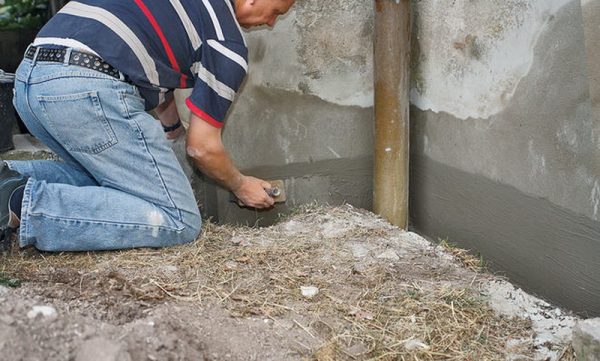
Ready-made compounds
Most major manufacturers produce specialized plasters for basement based on cement, fractional sand and chemical additives. The latter enhance adhesion, strength and improve the quality of the coating. Here are the most popular brands:
- Knauf Sockelputz;
- "Volma Cap";
- “Eunice Silin the Basement”;
- Bergauf Unter Bau;
- “Found Startwell”;
- "Rusean Facade."
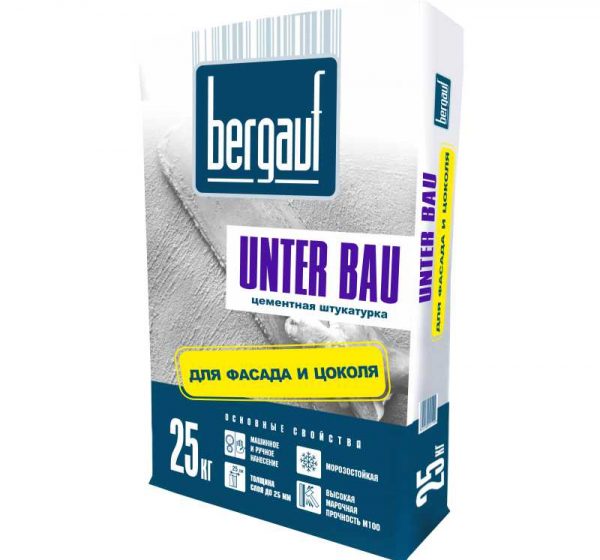
to contents ↑Some of the plasters in the composition additionally contain solid mineral components - quartz, marble, granite chips. They make the coating more decorative and increase its wear resistance by an order of magnitude.
Homemade plaster for plinth
If you buy enough cement and sand, plaster for the base can be done with your own hands. It is important only to immediately select high-quality cement. For facade-basement works, the M400 or M500 brand is well suited, and in the first case, 3 parts of sand are taken for one part of cement, and 4 parts in the second. Sand should also be suitable for work - career (not river), clean, without additional inclusions. It is sifted through a sieve with small cells in order to finally get rid of clay, pebbles, plant debris. After that, dry components are combined in the concrete mixer, which then will need to be mixed with the liquid.
As a solution of the required density is obtained, plasticizing and water-repellent additives are introduced - PVA, Latex Profi polymer adhesive additive, Aquatron, Hydrotex, Penetron substances, etc. Also pigments or colorants can be added at this stage. The finished composition should be fluid for the primer layer, plastic - for the finish layer.
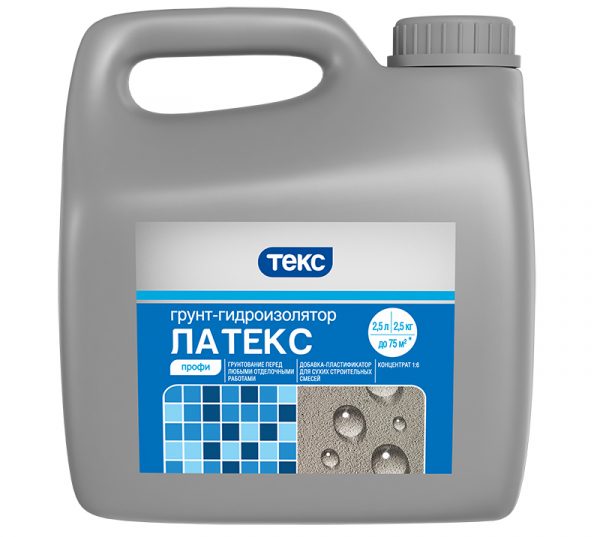
Surface preparation
The upper part of the base can be made of different materials. Often, its lower zone is monolithic, and above it is a superstructure of brick, foam fibroblock. Depending on the specific material, the procedure for preparing the surface for plastering will be different.
Brick base preparation
If the base is made of brick, it has many seams that are filled with cement mortar. Over time, the cement shrinks, crumbles, cracks appear in the joints, which sometimes expand to a considerable size.During the preparatory measures, it is important to completely remove all loose particles, falling fragments with the help of a spatula or a metal brush. You also need to completely sweep out the dust, all the smallest elements, sand. Large pieces of old plaster beat off with a chisel, hammer. All defects that are formed are moistened with water, laid with bricks of a suitable size, which are placed on a cement mortar. Small voids are simply covered with cement plaster.
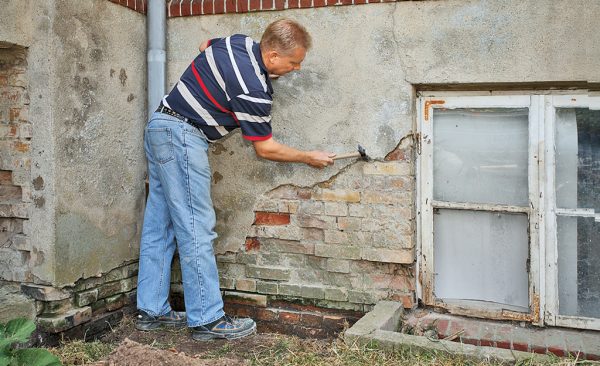
Preparation of rubble and concrete base
Such surfaces require even more thorough preliminary measures. Old, spoiled masonry elements are removed, replaced with new ones. You can also carefully get the shattered "details", clean them thoroughly and return to their original place. The stones are fixed on a regular cement-sand mixture.
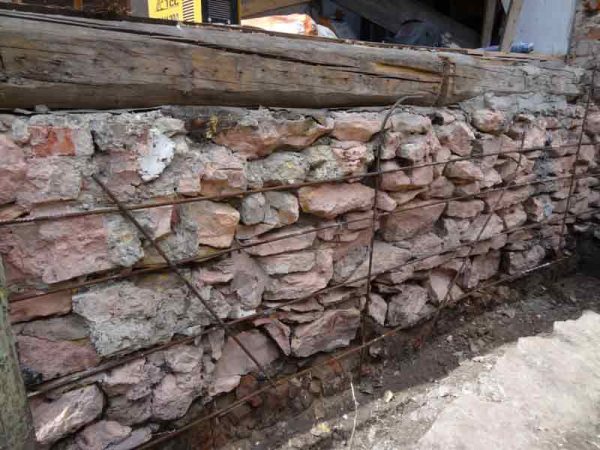
Preparation of concrete and reinforced concrete foundations
Cracks on such a foundation appear less frequently. Nevertheless, if they are available, it is necessary to evaluate the edge strength of each defect, remove all crumbling crumbs. Small potholes can be leveled with a cement mixture even without cleaning. If there are signs of partial displacement of the base, it should be strengthened.
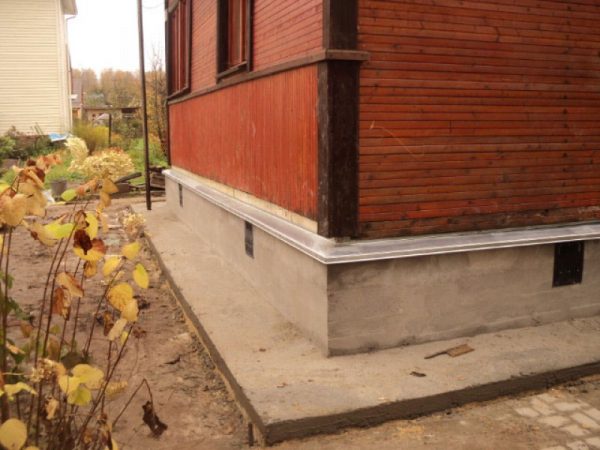
Tools and consumables for work
In addition to the finished building mixture or self-prepared mass, you need to prepare such accessories for work:
- metal laths beacons;
- spatulas;
- rule
- trowel or grater;
- primer;
- hatchet;
- plaster grid;
- edged boards 20-30 cm wide;
- dowels;
- electric drill with mixer nozzle;
- concrete mixer;
- wide brush;
- construction level;
- shovel;
- hammer and punch;
- stiff brush;
- grinding machine;
- plaster bucket.
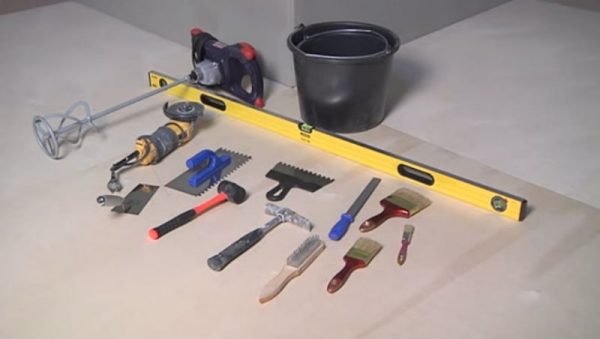
If you want to get a colored or decorative surface of the solution, you should immediately prepare the pigments, marble or granite chips.
to contents ↑Base plastering technology
The process will consist of several stages - preparation, priming and application of the solution, as well as its decoration. There are several auxiliary steps in the work. Preliminarily assess the scale of action, buy the required amount of plaster with a margin of 15-20%.
Preparatory work
Preparation is reduced to high-quality cleaning of the base, cleaning out the dried-out solution from cracks, crevices, and joints between the blocks. Large cracks broaden - deepen and make wider to exclude the appearance of weakened areas. In the cross section, defects should acquire a triangular shape. Then they close up with a solution, give it gain strength (therefore, it is advisable to carry out restoration work in advance).
Sweep away all dirt, debris, dust particles. It is most convenient to clean the base with a grinder, but this can also be done manually. A hatchet is applied to the surface, which will increase the adhesion area of the plaster with the base and increase adhesion.
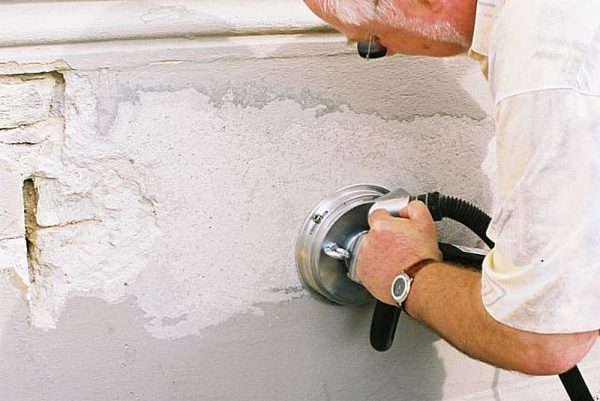
Soil application
Beginners often neglect priming, but it is a must! A deep penetration primer will strengthen the base itself and the wall, provide a higher level of adhesion. It is better to choose a soil with hydrophobic properties, which will increase the moisture resistance of the foundation. Products based on polyurethane, acrylic or epoxy are invariably considered the highest quality. Particular attention during processing is given to cracks, seams, joints and defects.
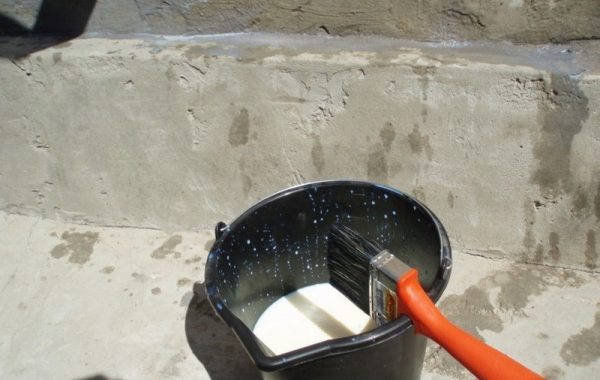
Fixing plaster mesh and insulation
Since the thickness of the plaster layer is significant, a stucco mesh is used to hold it. It is fixed throughout the structure with metal spacers with an L-shaped tip, which will seriously strengthen the base.
If it is planned to insulate the surface of the base, use mineral wool or tile insulation.Adhesive for thermal panels is applied directly to the primed base, the insulation is fixed, supporting it with a metal profile from below. Also, fasteners with wide hats can be used as fasteners.
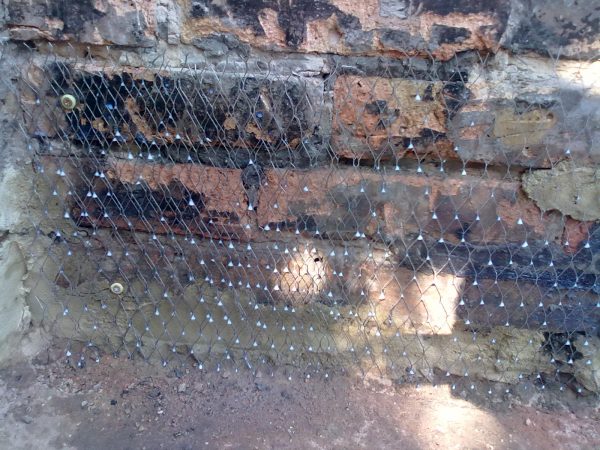
Installation of beacons
To evenly apply a layer of plaster, beacon technology is used. Install beacons in any convenient way over the entire surface of the basement with a step slightly smaller than the size of the rule. The distance from the extreme marks to the corners should be 20-30 cm. The easiest way is to set the beacons on plumb lines, as when working with internal walls. If the house does not yet have a blind area, even pegs are driven into the ground in a horizontal line parallel to the base 2 cm from it.
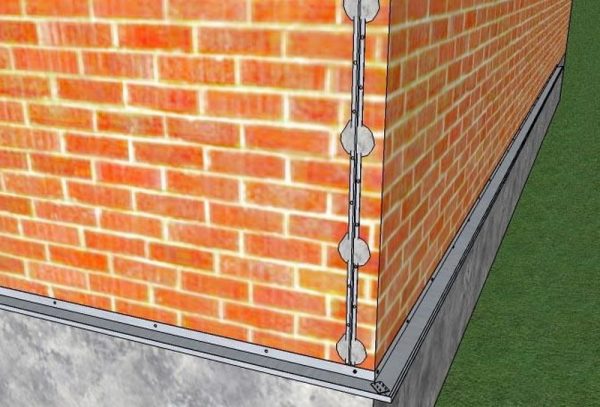
Spray
The purpose of this plaster layer is to roughly level the surface vertically and form a reliable foundation for subsequent layers. To perform a spray, an edging board is horizontally imposed on the upper part of the base so that it protrudes above the edge to the thickness of the plaster. To fix the board, apply small heaps of mortar after 30-40 cm and level the structure.
To properly plaster corners, put vertical boards on them, forming a fenced area. It will need to be further uniformly filled with solution in the future. Spray produced in vertical stripes manually or with a plaster bucket, which is much more convenient. The thickness of this layer should be 1-2 cm less than the upper edge of the beacons. After spraying the plaster, level it with a trowel. For perfect fixing of further layers, the surface is covered with small scratches with a spatula or trowel.
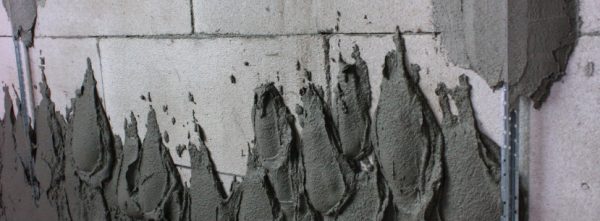
Plastering
The next layer - soil - is applied after setting spray (after 72-96 hours). If it is hot outside, it is recommended to hang the cap with a damp cloth, periodically wetting it with water. Soil allows you to fix the base before the finish. Its thickness should be 1-3 cm. Exceeding the indicator threatens the appearance of cracks. After leveling the primer, let it dry completely.
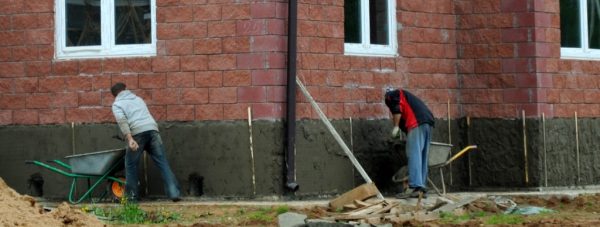
Grout
A trowel is required to eliminate the smallest irregularities and defects. Its thickness is small (2-3 mm), and the density of the solution resembles thick sour cream. It is advisable to add a little slaked lime to the building mixture, which will increase strength. At this stage, dyes are introduced, after diluting them in water.
Water is applied to the dried soil with a wide brush to slightly moisten the surface. Then the solution is smeared, triturated with a trowel. When the plaster ceases to adhere to the hand, grout with a building grater. In a circular motion, smooth the surface without strong pressure until it becomes smooth.
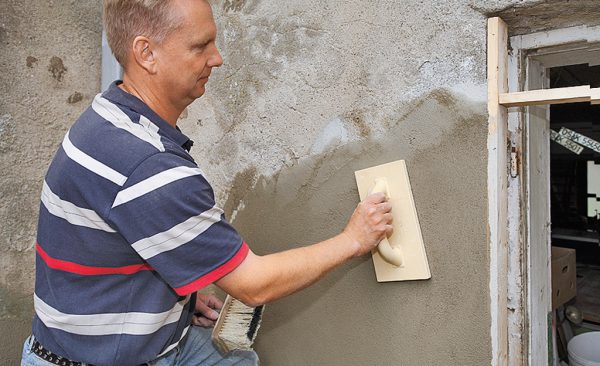
How to paint the base of the house with plaster
Finishing is carried out after the completion of all plastering work. Pay close attention to the choice of paint, because poor-quality paintwork will quickly fade, peel off. Usually they use good facade paints on an acrylic, silicone, combined base, which are characterized by wear resistance, elasticity, durability and vapor permeability. The color is chosen according to the general idea, taking into account the shade of the house and the roof. It is also permissible to stain the base with resin, which after drying will become dull and practically will not be subject to contamination.
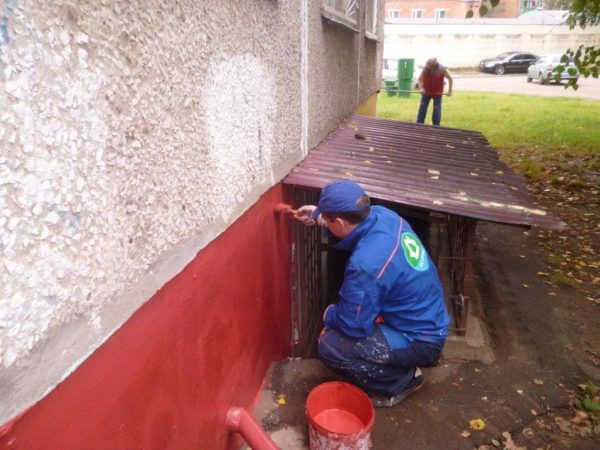
Features of decorative trim base
You can start staining 3 weeks after the completion of plastering. During the specified period, the plaster layer is protected by a waterproof film coating so that it is not damaged by rain and sun. Twice a day, the surface is sprayed with water. Further, facade paint is applied to the plaster or, if it has been pigmented in advance, they are limited to a transparent varnish. It is also permissible to use decorative relief plasters and even ceramic tiles.
It is considered popular to decorate the basement by creating a relief on pre-prepared stencils. Billets are applied to the still wet plaster, tap. After removing the stencil, a print of the drawing will remain on the base. Another finishing method is slotting. According to the solution, “stones”, “bricks” or other decorative elements are cut with a sharp tool. After drying, the drawings are coated with paint or varnish.
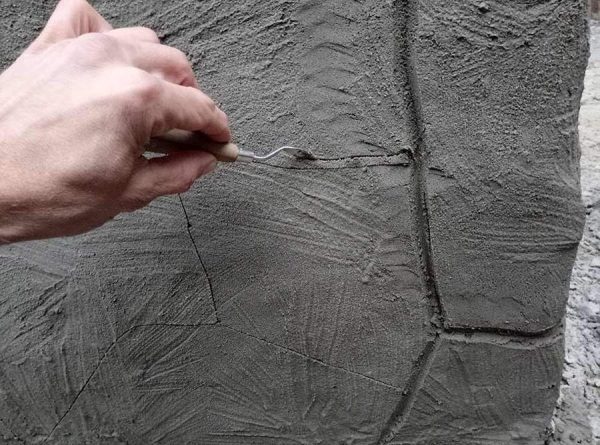
Decorative plaster "base stone"
To give the cap an original look, decorative plasters with a stone texture are used. Such mixtures can be made independently by adding colored quartz sand, marble chips, granite chips, finely crushed brick to the finished solution. The filler fraction may be 0.5-5 mm. The ideal option is to introduce stone chips into acrylic plasters, which have high elasticity and are applied to the base with an ideally even layer.
The thickness of decorative plaster is usually 0.5-1 cm. Such a layer is also sufficient to imitate masonry, when “pebbles” are drawn directly with the help of any sharp tool directly on the applied mass. To create a texture “under travertine”, two layers of mortar with the appropriate filler are applied and they pass along the surface with a metal brush, and then the plaster is slightly leveled with the trowel edge. To obtain the texture of a "fur coat" instead of a brush, use a fur roller.
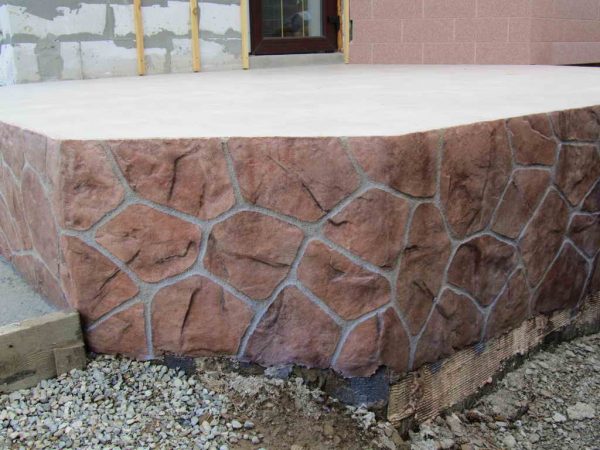
Wet facade plastering
A “wet” facade is a special plaster technology for which water-based decorative building mixtures are used. The order of work in this case will be as follows:
- prepare the base - level it, clean and remove serious defects;
- apply a primer layer;
- establish a base profile at a height of 30 cm from the ground using self-tapping screws;
- they mount the insulation with glue, allow it to dry for 3 days, then fix it with dowels;
- an additional adhesive layer for reinforcement is applied to the insulation, a mesh is installed, it is pressed;
- After a week, lay decorative plaster directly on the glue.
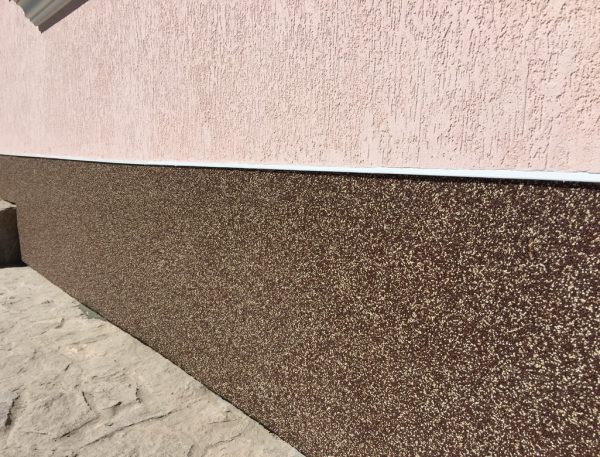
Plastering the base is a job that you can do with your own hands, while gaining very valuable experience. There are no high requirements for leveling, the surface area is small, so the task is feasible even for beginners.



